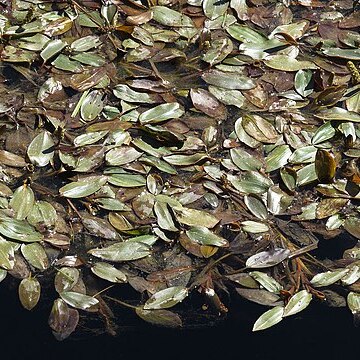Rhizomes buff, spotted or suffused with red. Stems simple or branched, terete, 5-60 cm long and 0.2-1.2 mm in diameter. Leaves eglandular, dimorphic without lacunae or with up to 2 rows of lacunae on each side of midrib; submersed leaves thin, elliptic to lanceolate, sessile or with petioles to 4.1 cm long, the blades acute to apiculate, 7-17-nerved, 5.7-17 cm long and 1-3.2 cm wide; float-ing leaves (often absent) more or less coriaceous, elliptic to oblong-elliptic, the petiole 3.2-8.5 cm long, the blades obtuse to apiculate, 11-13 nerved, 4.5-6.2 cm long and 1.5-3 cm wide; stipules light green to dark-brown, persistent, 1.9-6.8 cm long and 1.7-6.1 mm wide, convolute, 2-keeled, free from the blade, diver-gent and conspicuous. Winter buds unknown. Inflorescence a cylindrical spike, 2-4.5 cm long and 4.5-8.5 mm in diameter, consisting of 10-16 whorls of flowers, the whorls 1.5-5 mm apart; peduncles cylindric, erect, terminal, 4.8-16.2 cm long and 2.5-3.8 mm wide. Fruits olive-green to brownish, dorsally and laterally keeled, 2.2-2.7 mm long and 2.1-2.5 mm wide, keels without undulations, ridge-like, the dorsal keels 0.2-0.3 mm high, the lateral keels less developed but often with a projecting basal knob, beak (0.1-)0.3-0.6 mm long, 0.2-0.5 mm in diam-eter, sides flat, wall texture slightly reticulate.
Stem stout, usually much branched, to 2 m; submersed lvs lanceolate to oblanceolate or narrowly obovate, 8–20 × 2–5 cm, 9–19-nerved, acute, tapering to a sessile or short-petioled base; floating lvs not always developed, lanceolate to elliptic, 7–13 × 2–6 cm, the stout petiole 4–11 cm; stipules axillary, free, obtuse, 4–10 cm; peduncles 4–12 cm, usually thicker than the stem, but not clavate; spikes dense, cylindric, 2.5–6 cm; frs broadly semi-obovoid, 3–4 mm (including the 0.5 mm beak), with 3 conspicuous but low dorsal keels; 2n=104. In quiet water; N.S. to Ont., Minn., and Calif., s. to Fla. and Mex. (P. angustifolius; P. lucens, misapplied)

